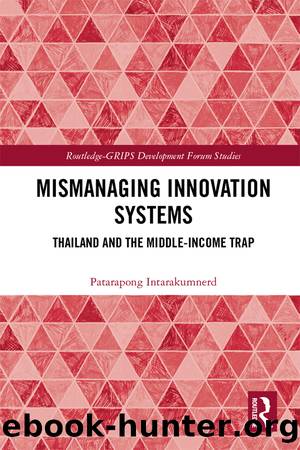Mismanaging Innovation Systems by Patarapong Intarakumnerd

Author:Patarapong Intarakumnerd
Language: eng
Format: epub
Publisher: Taylor & Francis (CAM)
6.3 Intellectual Property Rights (IPRs) regime
Patents have the greatest impact on industrial product and process innovation compared to other types of IPRs, like trademarks and copyrights. We will examine the evolution of the patent regime and its impacts on technological learning and innovation of firms in Thailand.
Evolution of Thailandâs patent regime
Prior to the promotion of patent law in 1979, there had been no protection for human invention or design in Thailand, unless it could fall under other areas of intellectual property. Later, the Patent Act of 1979 was proposed to promote the R&D of new inventions and designs that are useful to domestic agriculture, industry and commerce and to offer legal protection to inventors and designers by prohibiting others from copying or imitating their intellectual innovations (DIP, 2006).
To protect Thailandâs exports, particularly from countries which could pursue trade sanctions on Thailand because of the allegedly inadequate protection of intellectual property rights (especially the US Omnibus Trade and Competitiveness Act 1988: Section 301), the first amendment to the patent law was completed in 1992. The first amendment signified a change from weak to strong protection. The major changes included expanding the scope of patentable matters to food, beverages, pharmaceutical products and pharmaceutical ingredients, and extending the term of patent rights protection from 15 to 20 years after the filing date (see Kuanpoth, 2006). The amendment has also increased the rights of the holder of a process patent by including a monopoly right to import products produced directly by means of the patented process.
The second amendment was completed in 1999 to make the law comply with the Trade-Related Aspects of IPRs (TRIPS) agreement and other well accepted international standards. Under this amendment, the group of persons who may obtain patents in Thailand was extended to nationals, residents and those having a legitimate ongoing business address in any country that is a member of the Paris Convention or the World Trade Organisation (WTO). The one-year period from the first application for a patent for the invention anywhere in the world within which patent applications must be filed in Thailand was extended to 18 months. The number of exceptions to patent rights was reduced. The scope of compulsory licensing was restricted. Finally, a system of petty patents or the utility model was introduced. For a petty patent, an invention is eligible and accepted for registration if it makes the examiner believes that it is new and industrially applicable. Unlike patents, applicants of petty patents do not have to illustrate distinctive inventive steps. The initial term of a petty patent is six years from the date of filing with the possibility of two extensions of two years each. Petty patent is more suitable for incremental innovation which gives countries a greater chance to achieve during the catch-up stage. It is noteworthy that petty patents were introduced very late in Thailand to encourage local people to invent more and take advantage of this patent protection. This situation is different from that of the NIEs of East Asia, which introduced petty patents much earlier.
Download
This site does not store any files on its server. We only index and link to content provided by other sites. Please contact the content providers to delete copyright contents if any and email us, we'll remove relevant links or contents immediately.
Time Management Made Easy: How to Cultivate New Habits, Improve Productivity and Get Things Done by Joshua Strachan(2365)
The 7 Habits of Highly Effective People by Stephen R. Covey & Sean Covey(2098)
The Concise Laws of Human Nature by Robert Greene(1715)
Doesn't Hurt to Ask by Trey Gowdy(1555)
Primal Leadership by Daniel Goleman(1125)
Hook Point: How to Stand Out in a 3-Second World by Brendan Kane(1098)
HBR's 10 Must Reads 2021 by unknow(1044)
Don't Sweat the Small Stuff...and It's All Small Stuff by Richard Carlson(1013)
Amazon Unbound by Brad Stone(979)
100 Things Successful People Do by Nigel Cumberland(963)
HBR's 10 Must Reads 2021 by Harvard Business Review(956)
The Job Closer by Steve Dalton(939)
Master of One by Jordan Raynor(934)
Lives of the Stoics by Ryan Holiday & Stephen Hanselman(900)
Declutter Your Mind: A step by step guide to learn to control your thoughts, stop worrying, relieve anxiety and eliminate panic attacks and negative thinking by Mia Chandler(875)
The Power of 100! by Shaun King(844)
Conflicted by Ian Leslie(798)
Coders at Work: Reflections on the craft of programming by Peter Seibel(787)
The Book of Hope by Jane Goodall(744)
